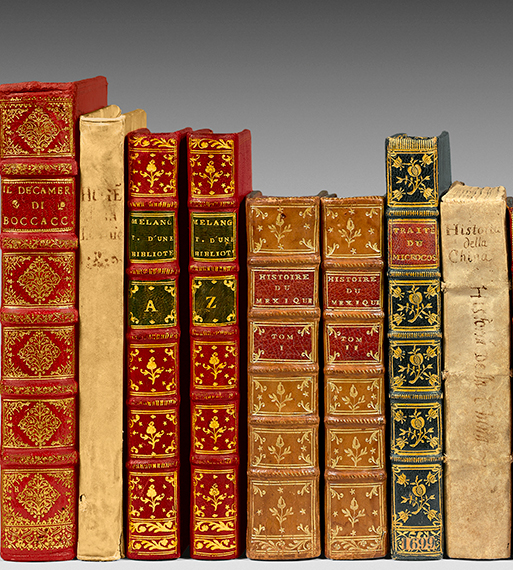“In my work, the poem The Angel Heurtebise has the importance of the Demoiselles d’Avignon
in Picasso’s work,” declares Jean Cocteau in The Defined Past in 1953.
Original edition printed in 355 copies, this one of the 5 extremely rare copies on China paper, adorned with a rayogram by Man Ray as the frontispiece.
Copy preserved in an admirable mosaic binding signed by Pierre-Lucien Martin.
Cocteau, Jean. The Angel Heurtebise. Poem with a photograph of the angel by Man Ray.
Paris, Librairie Stock, 1925.
In-folio of (2) blank leaves, (1) half-title leaf, 1 full-page photograph as frontispiece, (1) title leaf, (1) blank leaf, 16 leaves each bearing a poem on the front, (1) colophon leaf.
Half black box with bands, smooth spine with longitudinal title, boards adorned with a large polychrome mosaic composition of interlocking geometric shapes of colored glossy papers, gilt head, covers preserved, soft cardboard sleeve with transparent back, case, a small marginal tear on the title restored with no loss. Pierre-Lucien Martin, 1960.
Binding dimensions: 376 x 278 mm.
Original edition printed in 355 copies, this one of the 5 extremely rare copies on China paper.
This poem, written by Cocteau following the death of Raymond Radiguet in 1923, evokes the young novelist whose frontispiece is supposed to be his portrait.
Rayogram by Man Ray as frontispiece (Man Ray used this process starting in 1922 in an issue of Vanity Fair, then to illustrate Tristan Tzara’s spectacular avant-garde work, the Delicious Fields), “photograph of the angel” reproduced in photogravure.
The angel Heurtebise was a guardian angel, but also a sort of demon for the artistic jack-of-all-trades, Jean Cocteau. He appeared as a muse, but also as an angel of death and as a reincarnation of Cocteau’s lover, Raymond Radiguet, who died prematurely.
Legend has it that Cocteau was in an elevator when the angel spoke to him and revealed his name, identical to that of the elevator manufacturer, Heurtebise.
In a state of euphoria that lasted seven days, Cocteau wrote the poem The Angel Heurtebise, containing lines such as: ‘The angel Heurtebise on the steps’. Although the angel was supposed to be unknowable and invisible, the surrealist photographer, Man Ray, managed to fix him on the sensitive plate, with an image called ‘Rayogram’, which is created by placing an object on photo paper and then exposing it to light. This book was reproduced using the photogravure technique.
“In my work, the poem The Angel Heurtebise has the importance of Demoiselles d’Avignon in Picasso’s work,” declares Jean Cocteau in The Defined Past in 1953.
Elsewhere, he asserts that it is “the center of [his] poems, like the core of [his] poems” (Interviews with André Fraigneau, 1951). This highlights the importance he attaches to this text where his writing and imagination are renewed, even approaching to some extent the methods of surrealist automatic writing (a chapter from Journal of an Unknown narrates the birth of the poem).
This angel figure, far removed from traditional imagery, owes much to Radiguet’s appearance in his life and to his disappearance.
Copy preserved in an admirable mosaic binding signed by Pierre-Lucien Martin.
